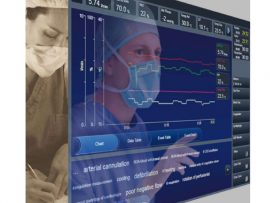Abstract Objectives Extracorporeal Life Support (ECLS) has evolved into an established treatment for severe cardiogenic shock. As most patients have residual antegrade left ventricular output toward the descending aorta that..
Read MoreAbstract Objectives Activated recombinant factor VII (rFVIIa) has been used to treat cardiac surgical bleeding in an off-label manner. Due to the high risk of mortality with ongoing hemorrhage, assessing..
Read MoreAbstract Low cardiac output syndrome (LCOS) is defined by an insufficient cardiac output to meet metabolic demands, leading to tissue hypoperfusion and potential organ dysfunction. Although it affects up to 42%..
Read MoreAbstract Introduction Viscoelastic point-of-care diagnostics are crucial in cardiac surgery. In the FIBTEM assay of rotational thromboelastometry (ROTEM), guidelines suggest target maximum clot firmness values to reduce perioperative bleeding. The..
Read MoreAbstract Background Respiratory management of extremely low gestational age neonates (ELGANs) is a major challenge in neonatal intensive care, as they face high mortality and morbidity due to complications such..
Read MoreAbstract Background Cardiopulmonary bypass (CPB) during cardiac surgery disrupts cerebral hemodynamics, potentially leading to postoperative neurological complications such as delirium. Transcranial Doppler (TCD) offers non-invasive monitoring of cerebral blood flow..
Read MoreAbstract Objective This study evaluated thrombus formation and its impact on outcomes in neonates and early infants undergoing congenital heart surgery. Methods Neonates and early infants (≤90 days) undergoing congenital..
Read MoreAbstract Background/Aim Recent literature suggested that the use of Minimal Invasive Extracorporeal Circulation (MIECC) may mitigate the inflammatory response in patients undergoing cardiac surgery. We aimed to perform a meta-analysis..
Read MoreAbstract Background Goal-directed perfusion (GDP) during cardiopulmonary bypass (CPB) seeks to match oxygen delivery with patient-specific metabolic demand, yet determinants of oxygen demand and dynamics of oxygen extraction ratio (OER)..
Read MoreAbstract Background Mortality in congenital diaphragmatic hernia (CDH) approximates 30 %. Both severe lung hypoplasia and other anomalies contribute to demise regardless of repair and/or extracorporeal membrane oxygenation (ECMO). We..
Read MoreAbstract Introduction: Ensuring radiation safety in healthcare settings is crucial to minimising risks associated with ionising radiation exposure. This study aimed to evaluate the knowledge and behaviours of operating room..
Read MoreAbstract Introduction Two techniques are commonly used for the femoral artery puncture closure during decannulation in venoarterial extracorporeal membrane oxygenation (V-A ECMO): the conventional post-closure technique and the small-sheath technique, also..
Read MoreAbstract Background Extracorporeal life support is influenced by membrane integrity and nutrition. The impact of parenteral nutrition with lipid injectable emulsions on membrane function remains uncertain. Methods This retrospective cohort..
Read MoreAbstract Cardiac procedures carry a higher perioperative risk than other operations for major adverse cardiovascular events and kidney injury, especially since patients with multiple comorbidities have been accepted as candidates..
Read MoreAbstract The use of extracorporeal life support (ECLS) throughout the perioperative phase of lung transplantation requires nuanced planning and execution by an integrated team of multidisciplinary experts. To date, no..
Read MoreAbstract Introduction In the postoperative intensive care setting after cardiac surgery with cardiopulmonary bypass (CPB), particularly in patients requiring continued anticoagulation for prosthetic devices such as mechanical valves or extracorporeal..
Read MoreAbstract Extracorporeal membrane oxygenation (ECMO) is an extracorporeal technique used in acute circulatory and respiratory failures refractory to conventional therapies. ECMO patients are at risk of developing severe acute kidney..
Read MoreGENERAL INFORMATION Language will be English. Intensive teaching program: 1 week (total fo over 50 hours). The program will be interactive, with lectures, case studies and a lot of time devoted..
Read MoreAbstract In these guidelines, the American Heart Association provides updated guidance for resuscitation of adults and children in cardiac arrest or with a life-threatening condition due to special circumstances, including..
Read MoreAbstract Objectives As postoperative mortality for paediatric cardiac surgery is very low, we aimed to develop methods for monitoring of postoperative complication rates, given their impact upon children’s health and..
Read MoreAbstract Introduction Blood damage during cardiopulmonary bypass can trigger postoperative inflammatory responses and organ injury. Therefore, optimizing the blood circuit design to minimize damage remains essential. However, variations in venous..
Read MoreAbstract Objective To determine the state of patient blood management (PBM) practice in leading US cardiac surgery centers. Design A survey tool addressing PBM program structure and PBM program operations..
Read MoreAbstract Background Following identification of widespread Mycobacterium chimaera infections in 2013 associated with aerosolization from Sorin heater-cooler-devices (HCD), microbiological monitoring of HCDs has become mandatory in Switzerland. Methods Since 01/2016, four Maquet..
Read MoreAbstract Hemolysis is a recognized complication of a microaxial flow pump (Impella CP) support, but its incidence and associated risk factors remain unclear. We retrospectively analyzed 24 patients with cardiogenic..
Read MoreAbstract Background: The purpose of this survey was to delineate and compare patient blood management (PBM) approaches in cardiac surgery across nine Middle Eastern countries while identifying the main challenges..
Read MoreAbstract Background Maintaining optimal anesthetic depth during cardiopulmonary bypass (CPB) in pediatric patients is challenging due to altered physiology and unreliable conventional monitoring. Entropy, a processed electroencephalogram metric, offers a..
Read MoreAbstract Objective To summarize the management experience of inter-hospital transport of critically ill children with extracorporeal membrane oxygenation (ECMO) in our hospital and provide evidence for the mobile ECMO for..
Read MoreAbstract To explore whether reducing airflow and maintaining blood flow can improve the success rate of the apnea test (AT) and whether two auxiliary test strategies can improve the completion..
Read MoreAbstract Cardiopulmonary bypass (CPB) is one of the most groundbreaking medical innovations in history, enabling safe and effective heart surgery by temporarily replacing the function of the heart and lungs...
Read MoreAbstract Background Intraoperative venoarterial extracorporeal membrane oxygenation (VA ECMO) is becoming the most common mode of extracorporeal life support (ECLS) in lung transplantation (LTx). We compared rates of primary graft..
Read More


















